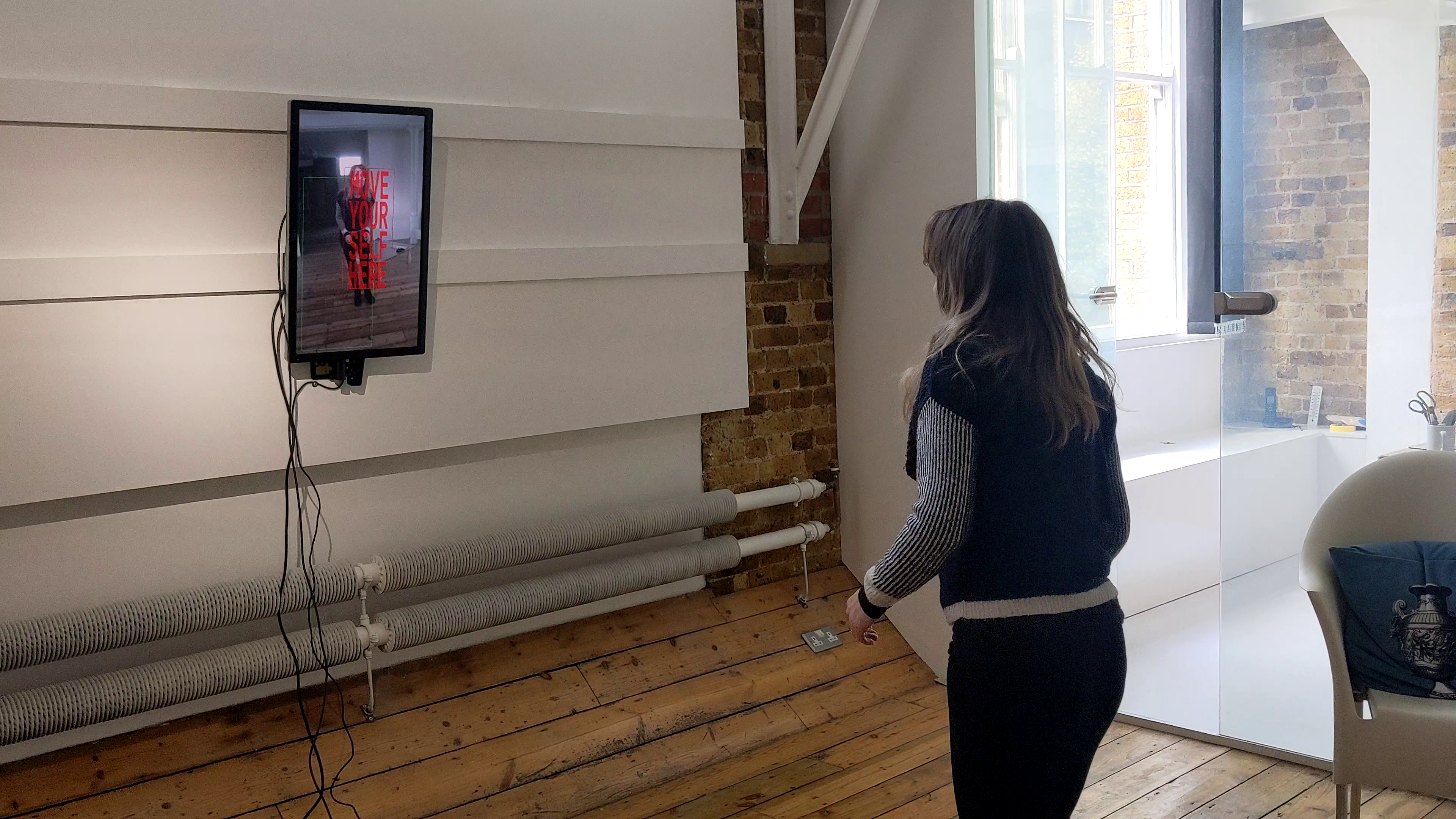Where Are You?
This piece aims to foster in the viewer a cognitive and physical awareness of their relationship to, and alienation from, the piece, its technological intent, and the space in which they are both located.
produced by: James Treagus
Introduction
We are used to being physically intimate with the technologies we interact with. Whether it is our smartphones or supermarket checkouts, most interactions, and certainly most display surfaces, are encountered at no more than arm’s reach. As such, they exclude any relation to the environment in which they are used from the interaction. This is, of course, intentional. That the interactions between the user and technology are able to take place irrespective of the surrounding environment is a key element of design for a lot of interactive technology -- ensuring that their functionality is retained in a wide range of deployment situations.
Breaking with this convention feels awkward. The work attempts to create a sense of alienation between the user and the focus of their interaction by increasing both the physical and conceptual remoteness of this object of intent. It does this by asking the viewer to occupy a space which constantly recedes from them, as though a conversational partner were to back away from you while never breaking eye contact. Further, the physical alienation of the viewer also forces them to take into account the architecture of the space which they inhabit. Thus architecture of the space in which the work is installed becomes incorporated as an essential component of the work.
Concept and background research
The work is inspired by the techno-city of the anime and manga series Blame!. This apparently infinate city does not recognise humans. It did once, but a virus mutated the gene which the humans used as a marker to interface with and control the machines. Generations later, humans find themselves alienated within a vast unending mechanical landscape, which, at best, is ambivalent to their presence, and at worst, actively hostile. The environment -- which is always architectural -- in Blame! broods in the background. The city becomes an antagonist which is ever present and unescapable.
This piece attempts to recreate the sense of cognitive and spatial alienation from technology and environment which Blame! invokes.
Technical
The work consists of a webcam mounted on top of a screen which displays the scene before it. It uses facial tracking to place a bounding box around the viewer’s body, before asking them to align their physical form within a second bounding box in order to begin interacting with the work. This second box, however, is not user friendly. It is always too small and constantly shifts itself away from the user's attempts to occupy it. As the viewer naturally adjusts their position to comply with the request, they must either contort themselves into an ever smaller space or else step away from the piece, so that their image appears smaller on the screen. Registering this, the software adjusts the size and position of the second box, keeping it perpetually out of reach. If and when the software is no lnger able to keep track of the individual the on screen message changes, from asking the viewer to move, to asking them 'Where are you?', both a request by the software which has registered the loss of the individual and an appeal to the individual to consider their new situation.
Self evaluation
Overall I feel that the piece mostly achieved the goals which were set out. However, watching users interact with the piece it was clear that although they were considering themselves and the space they were inas intended, their focus remained largely on, and kept returning to, the screen. This might have prevented the work from being as successful as it could have been.
Future development
- It would be interesting to see if expanding the concept from being focused on a singular screen to something which is embedded into the wider environment would aid the concept.
- Currently the software can only handle tracking one person at a time, it would be good to increase the interactivity of the piece to be able to expand this to multiple persons.
- The responsiveness of the software is not as optimised as it could be, as a result the frame rate is lower than I would like. While this may not effect the piece conceptually it does negatively impact the user experience.
- It would be interesting to see if expanding the concept from being focused on a singular screen to something which is embedded into the wider environment would aid the concept.
References
Baker, Christopher. et al. ofxPS3EyeGrabber, https://github.com/bakercp/ofxPS3EyeGrabber
Braitsch, Stephen. Wolf, Thomas. ofxParagraph. https://github.com/braitsch/ofxParagraph
Braitsch, Stephen. ofxSmartFont. https://github.com/braitsch/ofxSmartFont
Seshita, Hiroyuki. 2017. Blame!. King Records, Kôdansha, Netflix.

































































